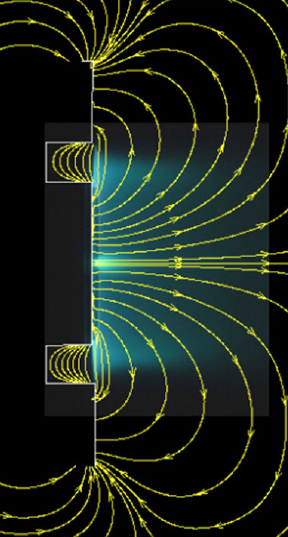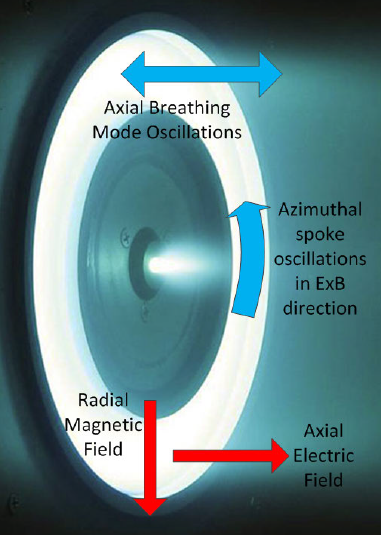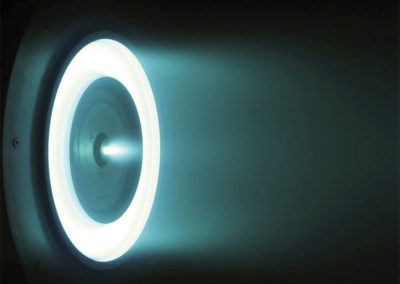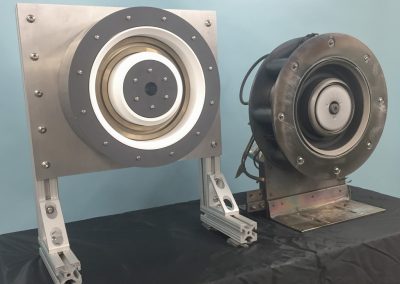Thruster
6-kW Hall Thruster (H6)
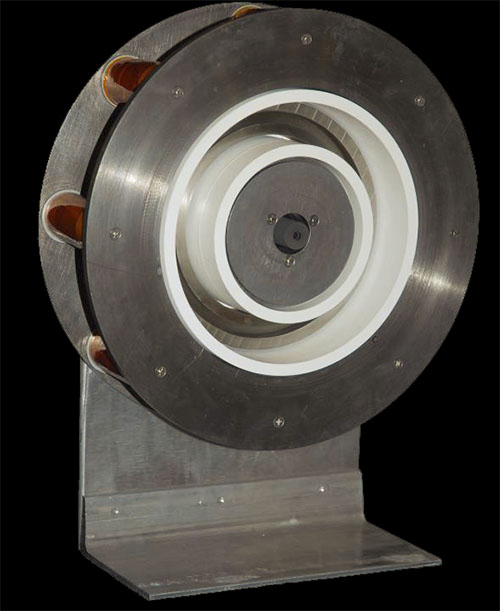
The H6 before first firing.
Developed
2007
Tested at PEPL
2008 – 2016
Developer
PEPL, AFRL, NASA JPL
“The H6 Hall thruster shown [in photos below] is a 6-kW class Hall thruster with a nominal design voltage of 300 V and a 7% CFF. It uses a hollow cathode with a lanthanum hexaboride (LaB6) insert that can either be mounted centrally (on thruster centerline which is the nominal configuration) or mounted externally. The inner magnet coil is one, continuously wound solenoid core while the outer coil consists of eight discrete solenoid cores wound in series and separated by 45 degrees. The outer pole is designed such that inside the discharge channel the magnetic field is azimuthally uniform to less than one Gauss. Note that the magnetic field within the discharge channel cross-section is radially symmetric about (mirrored above and below) discharge channel centerline from the anode to the exit plane, whereas the SPT-100 magnetic field is not. The H6 was a joint development effort of the University of Michigan, the Air Force Research Laboratory (AFRL) at Edwards Air Force Base (AFB), and the NASA Jet Propulsion Laboratory (JPL). A separate copy of the thruster is maintained at each institution. It is notable for its high total efficiency; e.g., 64% at 300 V (6 kW) with a specific impulse of 1950 s, and 70% at 800 V (6 kW) with a specific impulse of 3170 s. Slightly different nominal operating conditions are used between institutions.”
“At the University of Michigan, work by Reid, Shastry, Huang, and McDonald studied H6 operation between 5 and 30 mg/s flow rates, but primarily focused on 20 mg/s for 6-kW operation at 300 V. Work by Hofer at JPL has tuned the H6 to even discharge currents and power levels; i.e., 20 A for exact 6 kW operation at 300 V. For xenon these operating conditions vary only by a few percent in current or mass flow rate (1 mg/s Xe = 1 A discharge current), but peak magnetic field strengths between the two cases may vary by up to 15%. At the 300 V, 20 mg/s, 6.1 kW Michigan operating condition, the H6 has a 20.3 A discharge current and produces 397 mN of thrust at a specific impulse of about 1900 s. At the nominal 300 V, 20 A, 6 kW JPL condition, the specific impulse is 1950 s with a thrust of 401 mN.”
“Since first firing in 2006, the H6 has been well characterized by a variety of diagnostic and modeling techniques at Michigan, AFRL and JPL. Six experimental doctoral dissertations have focused on the thruster to date, which have spawned numerous associated conference and journal articles. Modeling of the H6 has been performed using the hybrid PIC simulation HPHall-2 and the more recently developed fluid code Hall-2De.”
(This summary was quoted directly from the dissertation of Michael Sekerak, “Plasma Oscillations and Operational Modes in Hall Effect Thrusters”, from the University of Michigan, accepted in 2014.)
Selected Publications
Design of a 6-kW Hall Thruster for High Thrust/Power Investigation
Haas, J. M., Hofer, R. R., Brown, D. L., Reid, B. M., Gallimore, A. D.
Performance Characterization and Design Verification of a 6-kWLaboratory Model Hall Thruster
Brown, D. L., Reid, B. M., Gallimore, A. D., Hofer, R. R., Haas, J. M., Larson C.W.
Compact Lab6 Hollow Cathode for a 6-kW Hall Thruster
Hofer, R. R., Goebel, D. M., Watkins, R. M.
Anode Design and Verification for a 6-kW Hall Thruster
Reid, B. M., Gallimore, A. D., Hofer, R. R., Li, Y., Haas, J. M.
High-Speed Interrogation of the Near-Field Plume of a 6-kW Laboratory Hall Thruster
M. McDonald and A. Gallimore
Investigation of Low Discharge Voltage Hall Thruster Characteristics and Evaluation of Loss Mechanisms
Brown, D. L.
The Influence of Neutral Flow Rate in the Operation of Hall Thrusters
Reid, B. M.

